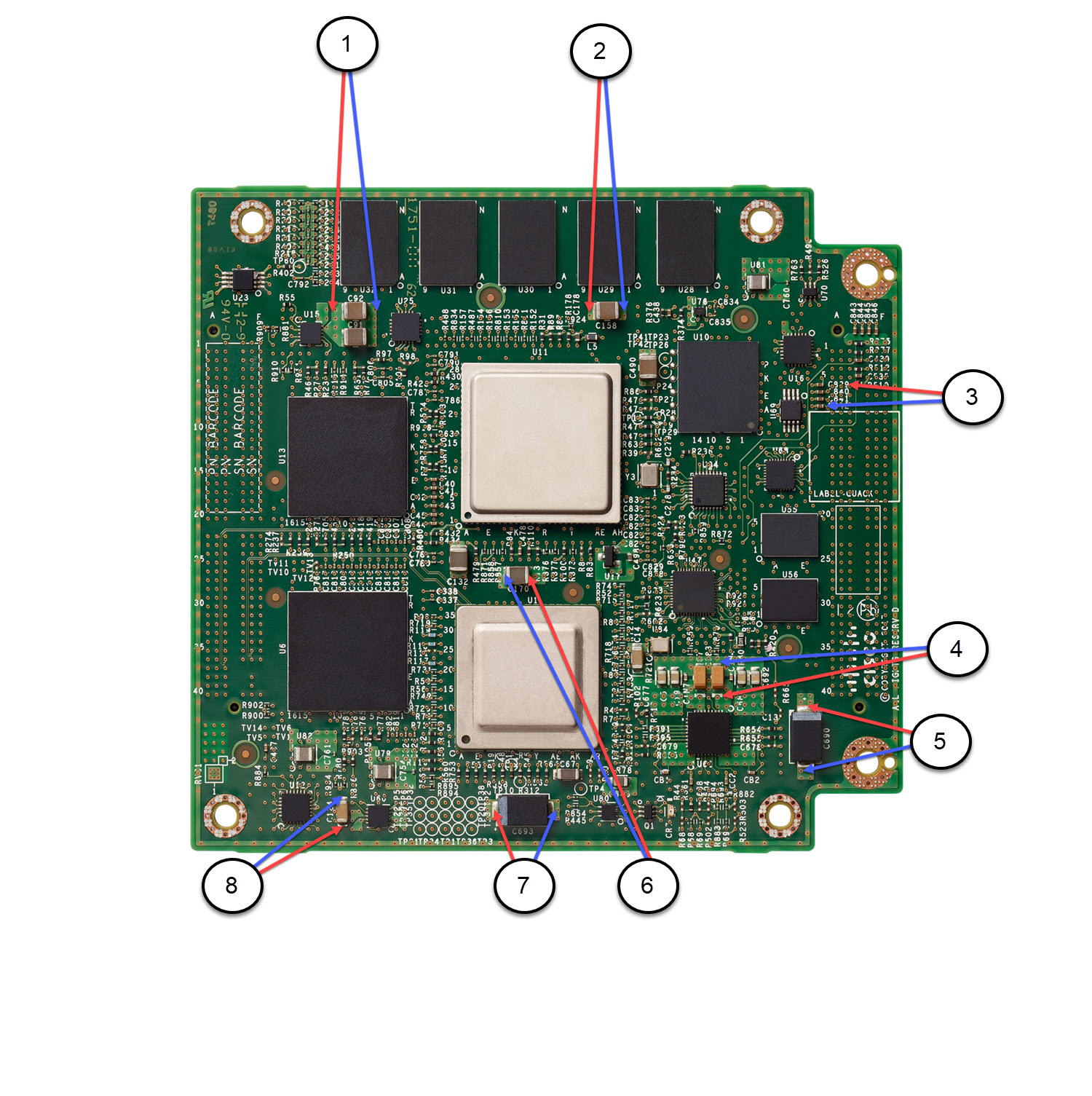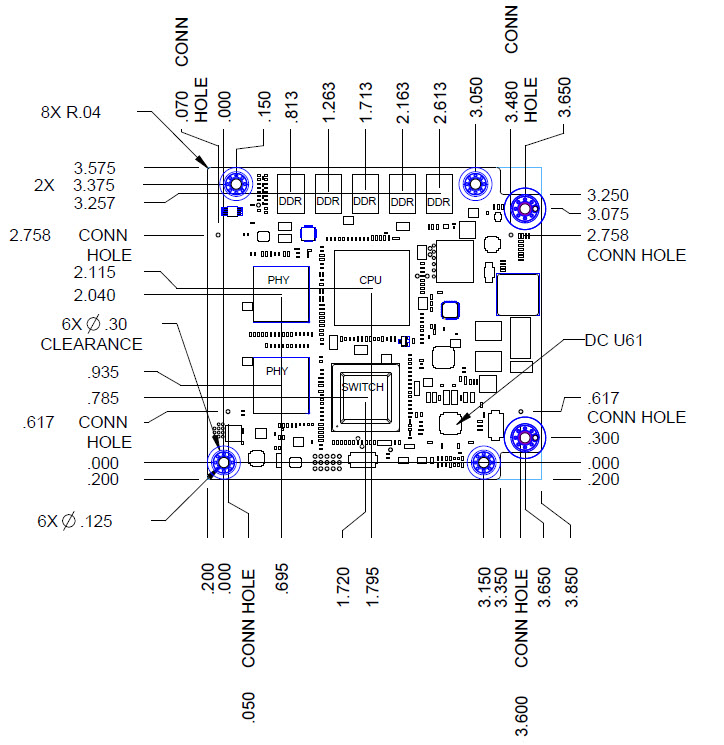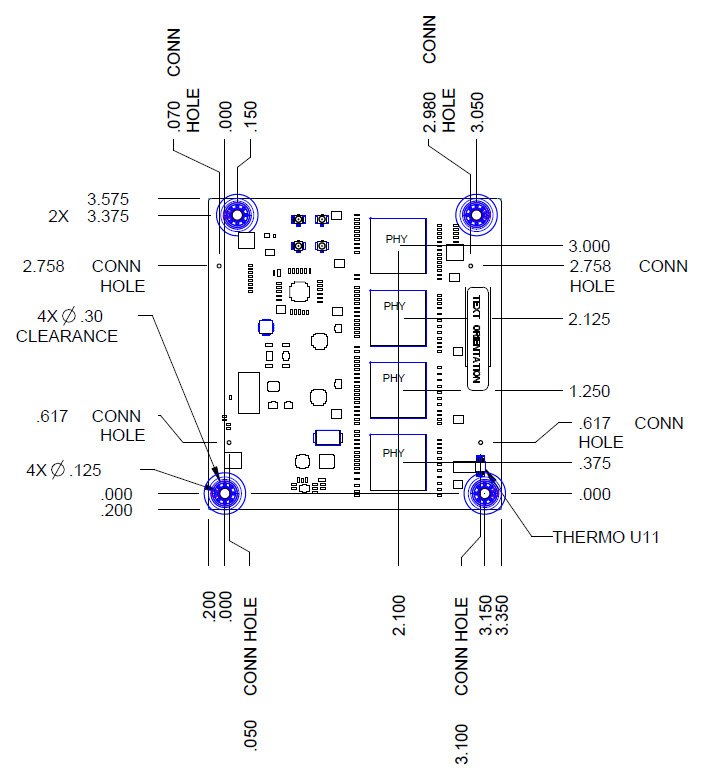LED Definitions
LED functionality is provided by a dedicated SPI controller for driving two LED shift chains for driving the LEDs on the integrator's board. The first LED shift chain connects all of the LEDs associated with the Main Board. The second LED shift chain connects all of the LEDs associated with the Expansion Board. You can select any combination of LEDs listed in the following table to implement. You are not required to implement all of the LEDs.
 Note |
Both shift chains are optional. If you want any functionality from a given shift chain, then you must provide the entire shift chain. For example, if you want the copper LEDs on the Expansion Module shift chain, you must also populate the shift register associated with the SFPs interfaces. |
|
LED |
Color |
Description |
|
|---|---|---|---|
|
System See Note below for further details about bootup behavior. |
Off |
System is not powered on. |
|
|
Flashing Green |
Power on tests in progress. |
||
|
Green |
System is operating normally. |
||
|
Yellow |
System fault detected. |
||
|
Power |
Off |
Power is not present or unit failed memory test. |
|
|
Green |
System is powered on. |
||
|
Alarm Out |
Off |
Alarm is not configured. |
|
|
Solid Green |
Alarm Out is configured, no alarm detected. |
||
|
Flashing Red |
Switch has detected a major alarm. |
||
|
Solid Red |
Switch has detected a minor alarm. |
||
|
Port |
Off |
No link or the port was administratively shut down. |
|
|
Green |
Link is present; no activity |
||
|
Flashing Green |
Activity. The port is sending or receiving data. |
||
|
Alternating Green and Yellow |
Link fault. Error frames can affect connectivity. Errors such as excessive collisions, cyclic redundancy check (CRC), and alignment and jabber errors are monitored for link-fault indication. |
||
|
Yellow |
Port is disabled. |
||
|
PoE |
Off |
PoE is off. If the powered device is receiving power from a non-PoE power source, the port LED is off even if the powered device is connected to the switch port. |
|
|
Green |
PoE is on. The port LED is green only when the PoE port is providing power. |
||
|
Alternating Green and Amber |
PoE is denied because providing power to the powered device will exceed the switch power capacity. |
||
|
Flashing Amber |
PoE is off due to a fault.
|
||
|
Amber |
PoE for the port is disabled. (PoE is enabled by default). |
||
|
Zeroize |
Off |
Normal operation. |
|
|
Flashing Green |
Factory default procedure has been initiated. |
||
|
Yellow |
Factory default procedure has completed; switch is about to reboot. |
||
|
Green |
Factory default procedure has completed. |
 Note |
The System LED will be solid green once the unit is booted up into IOS. That is the expected behavior. The LED should stop blinking shortly after the “Taking LC1 out of reset” text if you do not have an Expansion module. If you have an expansion module, the LED will stop blinking shortly after the “Taking LC3 out of reset” text. |
Main Board LED Register Bits
 Note |
Express Setup is not supported on the ESS3300 since the push button input and corresponding LED’s are dedicated to the Zeroize feature. Since the ESS3300 and IE3300 share a common architecture, any reference to Express Setup is reused for the Zeroize feature in the context of the ESS3300. |
The following table provides a listing of the Main Board LED register bits for the system integrator.
|
GPIO Position |
LED Function |
|---|---|
|
0 (Least Significant bit in byte, last to shift out) |
SYS Yellow LED |
|
1 |
SYS Green LED |
|
2 |
Express Setup Yellow LED |
|
3 |
Express Setup Green LED |
|
4 |
PoE Yellow LED |
|
5 |
PoE Green LED |
|
6 |
DC-A Yellow LED |
|
7 (Most Significant bit in byte, First to shift out) |
DC-A Green LED |
|
8 (Least Significant bit in byte, last to shift out) |
DC-B Yellow LED |
|
9 |
DC-B Green LED |
|
10 |
Reserved Yellow LED |
|
11 |
Reserved Green LED |
|
12 |
SFP Te1/1 Yellow LED |
|
13 |
SFP Te1/1 Green LED |
|
14 |
SFP Te1/2 Yellow LED |
|
15 (Most Significant bit in byte, First to shift out) |
SFP Te1/2 Green LED |
|
16 (Least Significant bit in byte, last to shift out) |
SFP Gi1/3 Yellow LED (i.e. Combo Port 1, SFP |
|
17 |
SFP Gi1/3 Green LED (i.e. Combo Port 1, SFP |
|
18 |
SFP Gi1/4 Yellow LED (i.e. Combo Port 2, SFP) |
|
19 |
SFP Gi1/4 Green LED (i.e. Combo Port 2, SFP) |
|
20 |
SFP Gi1/5 Yellow LED (i.e. Combo Port 3, SFP) |
|
21 |
SFP Gi1/5 Green LED (i.e. Combo Port 3, SFP) |
|
22 |
SFP Gi1/6 Yellow LED (i.e. Combo Port 4, SFP |
|
23 (Most Significant bit in byte, First to shift out) |
SFP Gi1/6 Green LED (i.e. Combo Port 4, SFP |
|
24 (Least Significant bit in byte, last to shift out) |
Gi1/3 Yellow LED (i.e. Combo Port 1, Cu) |
|
25 |
Gi1/3 Green LED (i.e. Combo Port 1, Cu |
|
26 |
Gi1/4 Yellow LED (i.e. Combo Port 2, Cu) |
|
27 |
Gi1/4 Green LED (i.e. Combo Port 2, Cu) |
|
28 |
Gi1/5 Yellow LED (i.e. Combo Port 3, Cu) |
|
29 |
Gi1/5 Green LED (i.e. Combo Port 3, Cu) |
|
30 |
Gi1/6 Yellow LED (i.e. Combo Port 4, Cu) |
|
31 (Most Significant bit in byte, First to shift out) |
Gi1/6 Green LED (i.e. Combo Port 4, Cu) |
|
32 (Least Significant bit in byte, last to shift out) |
Gi1/7 Yellow LED |
|
33 |
Gi1/7 Green LED |
|
34 |
Gi1/8 Yellow LED |
|
35 |
Gi1/8 Green LED |
|
36 |
Gi1/9 Yellow LED |
|
37 |
Gi1/9 Green LED |
|
38 |
Gi1/10 Yellow LED |
|
39 (Most Significant bit in byte, First to shift out) |
Gi1/10 Green LED |
|
40 |
Alarm Out / Overtemp Yellow LED |
|
41 |
Alarm Out / Overtemp Green LED |
|
42 |
Alarm In 1 Yellow LED |
|
43 |
Alarm in 1 Green LED |
|
44 |
Alarm In 2 Yellow LED |
|
45 |
Alarm In 2 Green LED |
|
46 |
Reserved Yellow LED |
|
47 |
Reserved Green LED |
Expansion Board LED Register Bits
The following table provides a listing of the Expansion Board LED register bits for the system integrator.
|
GPIO Position |
LED Function |
|---|---|
|
0 (Least Significant bit in byte, last to shift out) |
Gi2/1 Yellow LED |
|
1 |
Gi2/1 Green LED |
|
2 |
Gi2/2 Yellow LED |
|
3 |
Gi2/2 Green LED |
|
4 |
Gi2/3 Yellow LED |
|
5 |
Gi2/3 Green LED |
|
6 |
Gi2/4 Yellow LED |
|
7 (Most Significant bit in byte, First to shift out) |
Gi2/4 Green LED |
|
8 (Least Significant bit in byte, last to shift out) |
Gi2/5 Yellow LED |
|
9 |
Gi2/5 Green LED |
|
10 |
Gi2/6 Yellow LED |
|
11 |
Gi2/6 Green LED |
|
12 |
Gi2/7 Yellow LED |
|
13 |
Gi2/7 Green LED |
|
14 |
Gi2/8 Yellow LED |
|
15 (Most Significant bit in byte, First to shift out) |
Gi2/8 Green LED |
|
16 (Least Significant bit in byte, last to shift out) |
Gi2/9 Yellow LED |
|
17 |
Gi2/9 Green LED |
|
18 |
Gi2/10 Yellow LED |
|
19 |
Gi2/10 Green LED |
|
20 |
Gi2/11 Yellow LED |
|
21 |
Gi2/11 Green LED |
|
22 |
Gi2/12 Yellow LED |
|
23 (Most Significant bit in byte, First to shift out) |
Gi2/12 Green LED |
|
24 (Least Significant bit in byte, last to shift out) |
Gi2/13 Yellow LED |
|
25 |
Gi2/13 Green LED |
|
26 |
Gi2/14 Yellow LED |
|
27 |
Gi2/14 Green LED |
|
28 |
Gi2/15 Yellow LED |
|
29 |
Gi2/15 Green LED |
|
30 |
Gi2/16 Yellow LED |
|
31 (Most Significant bit in byte, First to shift out) |
Gi2/16 Green LED |
|
32 (Least Significant bit in byte, last to shift out) |
SFP Gi2/3 Yellow LED |
|
33 |
SFP Gi2/3 Green LED |
|
34 |
SFP Gi2/4 Yellow LED) |
|
35 |
SFP Gi2/4 Green LED |
|
36 |
SFP Gi2/1 Yellow LED |
|
37 |
SFP Gi2/1 Green LED |
|
38 |
SFP Gi2/2 Yellow LED |
|
39 (Most Significant bit in byte, First to shift out) |
SFP Gi2/2 Green LED |




 Feedback
Feedback